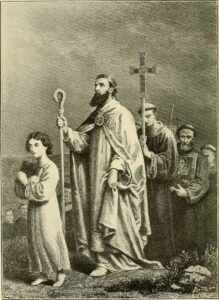shamrock

 While I don’t believe in luck, my family does come from strong Irish roots. I believe in blessing, so when I go for the “wearin o’ the green” so that I don’t get pinched, I choose something with an Irish blessing on it instead of a “lucky horseshoe” to adorn my green. There are many Irish Blessings, and my favorites are the ones that emphasize that blessings come from God, not from luck. These days, Sait Patrick’s Day celebrations have little to do with the original purpose of the day. The day was originally a day to honor a man…Saint Patrick, who was known as the “Apostle of Ireland.” He was considered the primary patron saint of Ireland.
While I don’t believe in luck, my family does come from strong Irish roots. I believe in blessing, so when I go for the “wearin o’ the green” so that I don’t get pinched, I choose something with an Irish blessing on it instead of a “lucky horseshoe” to adorn my green. There are many Irish Blessings, and my favorites are the ones that emphasize that blessings come from God, not from luck. These days, Sait Patrick’s Day celebrations have little to do with the original purpose of the day. The day was originally a day to honor a man…Saint Patrick, who was known as the “Apostle of Ireland.” He was considered the primary patron saint of Ireland.
Saint Patrick originally came to Ireland very much against his will. He was about sixteen, when he was captured by Irish pirates from his home in Britain and taken as a slave to Ireland. He writes that he lived there for six years as an animal herder before finally escaping and returning to his family. You might have thought that after such an ordeal, he would never want to go back, but after becoming a cleric, he returned to spread Christianity in northern and western Ireland. Saint Patrick went on to become a bishop, but little is known about where he worked. Nevertheless, by the seventh century, he had come to be revered as the patron saint of Ireland. To think about what he went through, and then the very fact that he returned, definitely makes him a saint to me.
While partying and drinking green beer, parades and bars, and wearing green clothing all seem to be the 
 normal way of celebrating these days, the reality is that this is technically a very religious holiday that is all about forgiveness, and a love of the people of Ireland. Some places hold parades and go all out with a party, but some people still feel more reserved about the day. Time changes things. It used to be that in Ireland, Saint Patrick’s Day was “celebrated” with church services, prayer, and a feast, but in modern times, there are a variety of types of celebrations, and while partying tends to cause a loss of the real reason for the day, it is a sign of the times, I suppose. However you celebrate, I hope you all have a great holiday. Happy Saint Patrick’s Day everyone.
normal way of celebrating these days, the reality is that this is technically a very religious holiday that is all about forgiveness, and a love of the people of Ireland. Some places hold parades and go all out with a party, but some people still feel more reserved about the day. Time changes things. It used to be that in Ireland, Saint Patrick’s Day was “celebrated” with church services, prayer, and a feast, but in modern times, there are a variety of types of celebrations, and while partying tends to cause a loss of the real reason for the day, it is a sign of the times, I suppose. However you celebrate, I hope you all have a great holiday. Happy Saint Patrick’s Day everyone.
 Today is Saint Patrick’s Day, but I don’t believe in Luck. I believe in blessed. Saint Patrick’s Day celebrations are all about “the luck” of the Irish. I’m not real sure where that idea got started, and I know that it’s all in fun, but luck isn’t real, and blessing is. Saint Patrick was born in Britain, but he was kidnapped by Irish pirates at 16 and enslaved for six years. They took him to Ireland where he was enslaved and held captive for six years. Patrick writes in the Confession that “the time he spent in captivity was critical to his spiritual development.” Often it is when we are our lowest time, that we finally look up and find the Lord. He explains that “the Lord had mercy on his youth and ignorance and afforded him the opportunity to be forgiven his sins and convert to Christianity.” While Saint Patrick was held in captivity, he was assigned to work as a shepherd, but while there, he also strengthened his relationship with God through prayer, eventually leading him to convert to Christianity.
Today is Saint Patrick’s Day, but I don’t believe in Luck. I believe in blessed. Saint Patrick’s Day celebrations are all about “the luck” of the Irish. I’m not real sure where that idea got started, and I know that it’s all in fun, but luck isn’t real, and blessing is. Saint Patrick was born in Britain, but he was kidnapped by Irish pirates at 16 and enslaved for six years. They took him to Ireland where he was enslaved and held captive for six years. Patrick writes in the Confession that “the time he spent in captivity was critical to his spiritual development.” Often it is when we are our lowest time, that we finally look up and find the Lord. He explains that “the Lord had mercy on his youth and ignorance and afforded him the opportunity to be forgiven his sins and convert to Christianity.” While Saint Patrick was held in captivity, he was assigned to work as a shepherd, but while there, he also strengthened his relationship with God through prayer, eventually leading him to convert to Christianity.
After six years of captivity, Patrick heard a voice telling him in a dream that he would soon go home, and then that his ship was ready. There was no “luck” to it. God spoke to him in a dream, and he obeyed. He was blessed with his freedom. He immediately took action, and escaping from his master, he  travelled to a port, two hundred miles away. Once there, Patrick found a ship and with difficulty persuaded the captain to take him. After three days of sailing, they landed, presumably in Britain. Odd that they didn’t seem to know. All the passengers and crew left the ship, walking for 28 days in a “wilderness” and almost starving to death. After Patrick prayed for sustenance, they encountered a herd of wild boar, and since this was shortly after Patrick had urged them to put their faith in God, his reputation as a man of God grew. By the time Patrick arrived back to his family, he was a young man of twenty years. Patrick continued to study Christianity.
travelled to a port, two hundred miles away. Once there, Patrick found a ship and with difficulty persuaded the captain to take him. After three days of sailing, they landed, presumably in Britain. Odd that they didn’t seem to know. All the passengers and crew left the ship, walking for 28 days in a “wilderness” and almost starving to death. After Patrick prayed for sustenance, they encountered a herd of wild boar, and since this was shortly after Patrick had urged them to put their faith in God, his reputation as a man of God grew. By the time Patrick arrived back to his family, he was a young man of twenty years. Patrick continued to study Christianity.
After making his escape, Saint Patrick, who wasn’t a saint then, made his way back to Britain, but Ireland beckoned him, and he would eventually go back there. Patrick had a vision a few years after returning home, “I saw a man coming, as it were from Ireland. His name was Victoricus, and he carried many letters, and he gave  me one of them. I read the heading: ‘The Voice of the Irish,’ As I began the letter, I imagined in that moment that I heard the voice of those very people who were near the wood of Foclut, which is beside the western sea, and they cried out, as with one voice: ‘We appeal to you, holy servant boy, to come and walk among us.'” A.B.E. Hood suggests that the Victoricus of Saint Patrick’s vision may be identified with Saint Victricius, bishop of Rouen in the late fourth century, who had visited Britain in an official capacity in 396. However, Ludwig Bieler disagrees. I guess we will ever really know.
me one of them. I read the heading: ‘The Voice of the Irish,’ As I began the letter, I imagined in that moment that I heard the voice of those very people who were near the wood of Foclut, which is beside the western sea, and they cried out, as with one voice: ‘We appeal to you, holy servant boy, to come and walk among us.'” A.B.E. Hood suggests that the Victoricus of Saint Patrick’s vision may be identified with Saint Victricius, bishop of Rouen in the late fourth century, who had visited Britain in an official capacity in 396. However, Ludwig Bieler disagrees. I guess we will ever really know.
Acting on his vision, Patrick returned to Ireland as a Christian missionary, and that is how he became a patron saint of Ireland. Saint Patrick actually never used a four-leaf clover, but rather he used a three-leaf clover as a way to help people to understand the Trinity (Triune God – Father, Son, and Holy Spirit).

